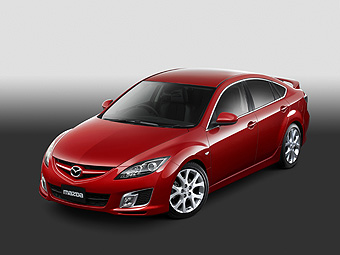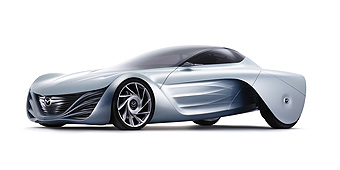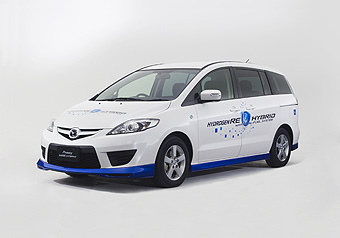NEWS RELEASES
Products and Technology
All-new Mazda Atenza and Mazda Taiki debut at the 40th Tokyo Motor Show
- New Mazda Premacy Hydrogen RE Hybrid also exhibited -
|
The all-new Mazda Atenza - soon to be introduced in Japan, the Mazda Taiki concept car, equipped with a next-generation rotary engine, the new Mazda Premacy Hydrogen RE Hybrid, a series of future-oriented powertrains, and a variety of environmental and safety technologies will be revealed by Mazda Motor Corporation (Mazda) at the 40th Tokyo Motor Show*1 in October 2007.
Mazda’s theme for the show is “Sustainable Zoom-Zoom— Mazda’s showroom today and in the future” under which new and exciting second-generation Zoom-Zoom products and future-oriented technologies will reflect the long-term research and development plans to support the “Sustainable Zoom-Zoom” program, Mazda’s long-term vision for technology development which was announced this spring.
The all-new Mazda Atenza premiered at the Frankfurt Motor Show, held last month in Germany, and was highly rated by journalists and visitors. Marking a quantum leap forward in blending driving pleasure with safety and environmental performance, this model embodies Mazda’s latest car-making philosophy and offers the ultimate long-distance touring experience, making it a striking statement of the evolution of Mazda’s Zoom-Zoom. At the Tokyo Motor Show, an even sportier and more distinctive model will be showcased for the first time.
Mazda Taiki continues the evolution of the Nagare design theme, following in the footsteps of the Mazda Nagare, Mazda Ryuga, and Mazda Hakaze concept vehicles. As the fourth in the series, Mazda Taiki further advances and refines the theme through a fusion of the Nagare (flow) design concept and real-world technologies, such as a next-generation rotary engine and enhanced aerodynamic performance. Mazda Taiki sets a new ideal for the front-engine rear-drive sports car of the future.
The new Premacy Hydrogen RE Hybrid is equipped with a transverse hydrogen rotary engine, featuring Mazda’s hydrogen/gasoline dual-fuel system. The hybrid system efficiently converts energy from hydrogen combustion to electricity and uses it to power the motor. This vehicle promotes practical use thanks to an extended hydrogen-fueled range, and enhanced driving performance and packaging. Leasing is now planned to commence in 2008.
In the decade following 2010, Mazda will revise its entire powertrain series, aimed at reaching “Sustainable Zoom-Zoom” with the emphasis on enhanced fuel and emissions performance, combined with superior driving performance. These next-generation powertrains will be on display, along with the many safety technologies currently under development to realize sustainable transportation systems.
Mazda will hold its press conference at 15:10 on Wednesday, October 24.
List of Major Exhibits
A total of 23 vehicles will be exhibited. On press day, October 24, 17 vehicles will be displayed.
Major Exhibits All-new Mazda Atenza, scheduled for imminent market introduction, embodies Mazda’s latest car-making philosophy: Zoom-Zoom Evolution. Along with enhanced environmental and safety performance, the new model has a more emphatic Mazda character in its design, dynamic performance, packaging and craftsmanship. It delivers the best high-speed long-distance touring experience, thanks to dynamic high-speed performance with class-leading aerodynamics, supported by leading-edge safety features and excellent driving characteristics. Three body types are offered: 4-door sedan, 5-door hatchback (Sport), and station wagon (Sport Wagon). The new MZR2.5L gasoline engine—developed from the current MZR2.3L gasoline unit—yields more torque in the frequently-used range, more linear response and acceleration feel, as well as more economical operation. Exterior and interior design create a sporty character along with an emotion–pleasing, premium feel. At the Tokyo Motor Show, a bold new sportier version with large front and rear aero bumpers, sporty grille and side spoilers is displayed for the first time. The vehicle also features advanced safety technology including an Rear Vehicle Monitoring system, a first for a Japanese vehicle, and CF-Net (Cross Functional-Network) multi-control system which provides integrated control of audio, climate control and other systems through simple, smooth operation that minimizes movement of the driver’s line of sight.
Mazda Taiki Mazda Taiki reflects one possible direction for a future generation of Mazda sports cars aimed at helping create a sustainable society. The fourth concept car in the Nagare design series, Mazda Taiki further evolves the “flow” theme to establish a breathtaking presence that clearly distinguishes it as the next in the series, and which visually expresses the atmosphere – called taiki in Japanese – that wraps the Earth in its protective mantle. The basic proportions begin with the stretched coupe form of a front-engine rear-wheel-drive layout, the short overhangs, and the liberating feel of an all-glass canopy. The challenge to create “a design that visually expresses the flow of air” was inspired by the image of a pair of Hagoromo – the flowing robes that enable a celestial maiden to fly in Japanese legend – floating down from the sky. Inspired by Japanese koinobori – the decorative “climbing carp streamers”– the notion of creating an Air-tube became the concept word for the interior design. In accordance, from the dashboard and seats down to the door trim, the interior space creates the dynamic sensation that the flow of the wind is being visually depicted. Centering around the performance rotary engine sports packaging that is synonymous with the Mazda name, technologies introduced for the Mazda Taiki include the next-generation RENESIS (rotary engine 16X), which sets new standards for environmental and driving performance, a front-engine rear-drive layout, a unique 2-seat configuration, and Mazda’s rotary sports package, which conveys an image of lightness. The effect integrates the design theme perfectly to realize outstanding aerodynamic performance.
New Mazda Premacy Hydrogen RE Hybrid Compared with the Mazda RX-8 Hydrogen RE, the new Premacy Hydrogen RE Hybrid yields 40% better output, resulting in enhanced acceleration performance and an extended hydrogen-fueled range of about 200km, or twice that of the RX-8 Hydrogen RE. Seating capacity is also increased to give accommodation for five adults along with greater luggage space. The hydrogen rotary engine is changed from a longitudinal to a transverse layout and its intake/exhaust resistance and combustion efficiency are improved to yield high output across a wide range of engine speeds. The hybrid system employed for the hydrogen rotary engine efficiently converts energy from hydrogen combustion into electricity that powers the electric motor. Thanks to progress in electric drive technology, the system realizes high energy-efficiency and a quick response allied with low fuel consumption. Acceleration kicks in the instant you hit the accelerator, creating a direct feeling of power.
2. Technical Exhibits With the next-generation 2.0L gasoline engine, we are aiming for a 15% to 20% increase in dynamic performance and a 20% increase in fuel economy (in-company comparison with the current 2.0L engine). Particular attention was paid to direct injection, combustion control, variable valve system technology and emission purification technology to reduce all energy losses and raise thermal efficiency. Further, Mazda is developing a new catalyst employing single nano technology*3 that simultaneously improves emissions-cleaning capability and reduces the volume of precious metal required in a 3-way catalytic converter.
Next Generation Clean Diesel Engine In developing our next-generation 2.0L diesel engine, we aimed at emissions performance to meet global standards and fuel economy raised by as much as 10%. We are also pursuing the kind of performance that allows stress-free driving up to high engine speeds. To fulfil our aims, we are promoting direct piezo-injection technology enabling multi-stage injection, reduction of the weight and size of every reciprocating and rotating component as well as the aluminum cylinder block. A two-stage turbocharger is adopted to yield both high torque in the low rev range and an increased acceleration response. The most advanced catalyst technologies, such as a highly efficient catalyst to burn particulate matter, are also fitted.
Next Generation RENESIS (Rotary Engine 16X) In developing the next-generation RENESIS, Mazda made a thoroughgoing revision of engine dimensions including the trochoid rotor housing, adopting a longer stroke and larger displacement of 1600cc (800cc x 2) aimed to raise thermal efficiency and boost torque at all engine speeds. By employing the Hydrogen RE design policy of a direct injection system and aluminum side housing, as well as various other measures, we are further promoting the rotary engine’s merits of light weight and compact size.
SISS (Smart Idle Stop System) Mazda’s SISS restarts the engine without using an electric motor. The system injects fuel directly into the cylinders while the engine is stationary and ignites the fuel to create downward piston force that serves to start the engine, resulting in fuel savings of about 10% in Japan’s 10-15 mode in addition to restarting the engine quickly and quietly.
Safety Technologies Radar sensors in the left and right rear corners of the body detect a vehicle approaching from the rear or in the blind area behind the B-pillars. The system is active when traveling at 60 km/h or faster.
Multi-control system CF-Net (Cross Functional-Network) (Installed in all -new Mazda Atenza) A centralized display above the instrument panel close to the driver’s line of sight and steering wheel switches within easy reach of the driver allow easy, integrated operation of audio, climate control, touring computer and other systems.
Roll stability control system (Installed in Mazda CX-9 for North America) The system maintains a stable vehicle attitude by ascertaining the absolute roll angle at any given moment through a combination of information on the vehicle’s roll movements provided by the roll rate sensor, and data on steering angle, lateral G-force, yaw rate and vehicle speed from the DSC (Dynamic Stability Control) system.
Driving assistance technology coordinating with transport infrastructure Mazda is participating in an ITS*4 public road test to be held in Hiroshima under the auspices of an organization made up of government, business and academic institutions. The test is scheduled to begin in the fall this year. We are in charge of developing a navigation system that supports ITS in this test on public roads and we will collect and analyze data from systems installed in several dozen Mazda vehicles. We are also developing an infrastructure-cooperative driver support system that will allow the driver to receive relevant information from sensors, beacons and other devices installed on the road. The support system includes a right-turn collision prevention support system, a blind corner collision prevention support system, and a system to support the prevention of rear-end collisions when waiting at traffic signals. Mazda is actively promoting this kind of road-human-vehicle interface and control technology approach,.
|
|||||||||||||||||||||||||


